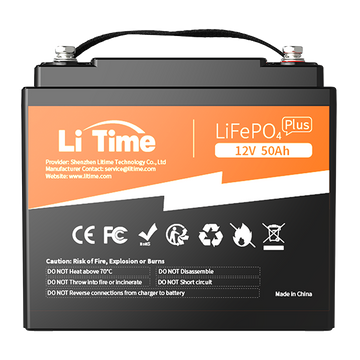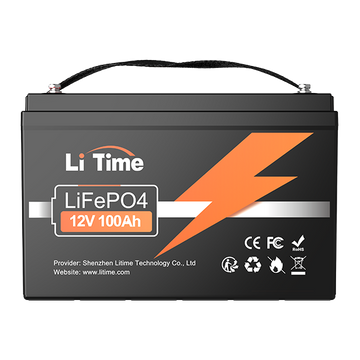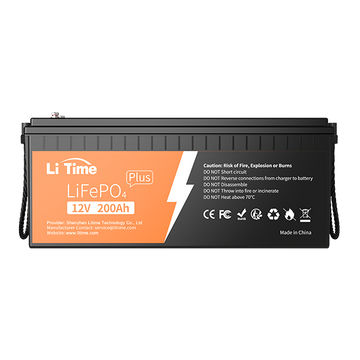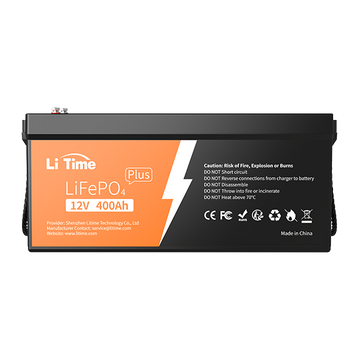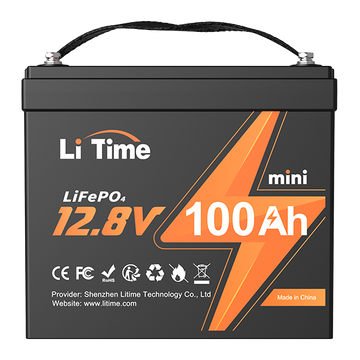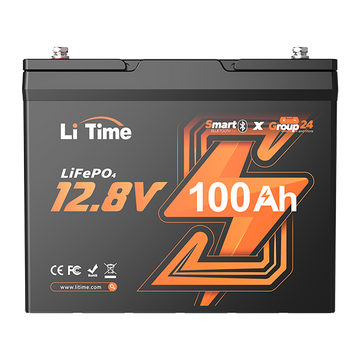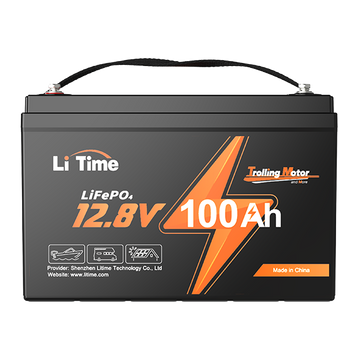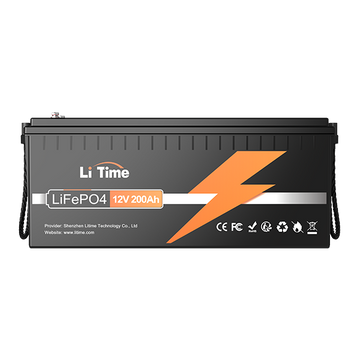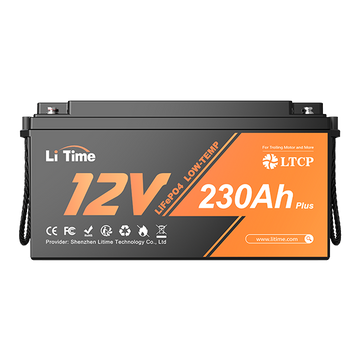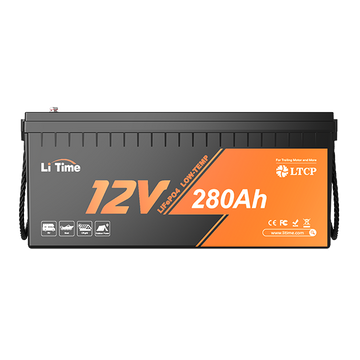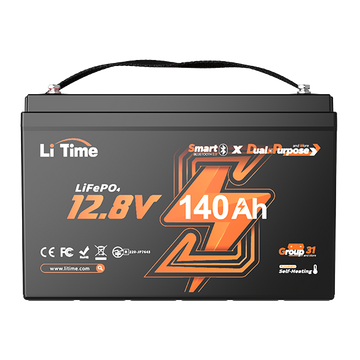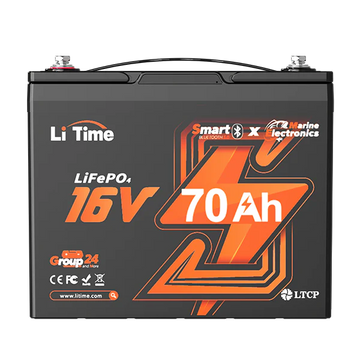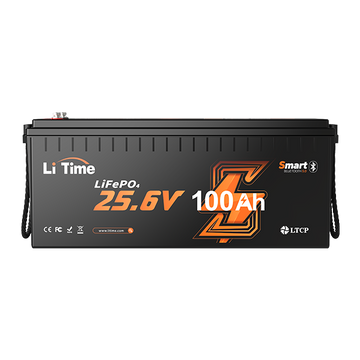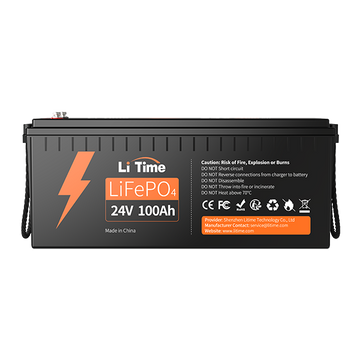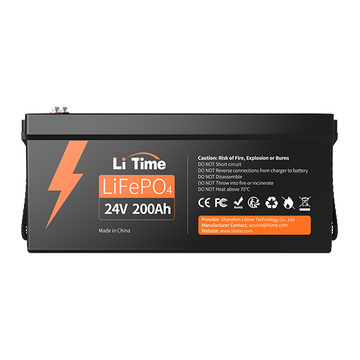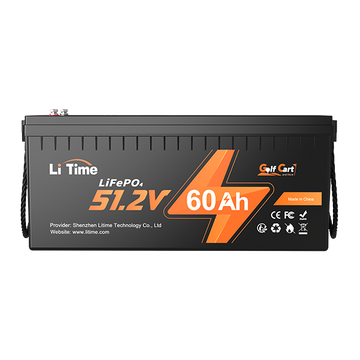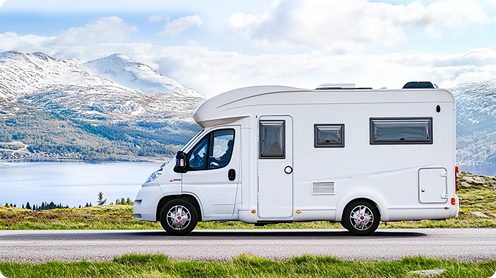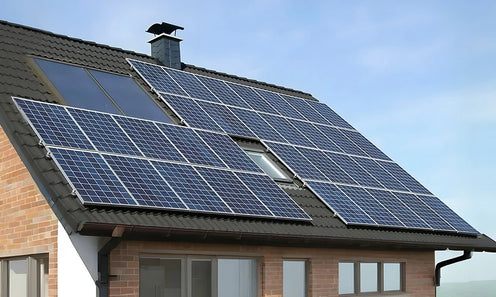Lithium Ion Golf Cart Batteries are rapidly becoming a mainstream choice in the golf cart battery market, and for good reason. Compared to traditional lead acid batteries, lithium ion batteries—particularly Lithium Iron Phosphate (LiFePO4)—offer significantly longer lifespans, faster charging times, and lighter weight, bringing about a substantial upgrade in performance. This guide will provide you an in-depth explanation of lithium ion golf cart battery types, their benefits, and step-by-step replacement instructions to help you make an informed upgrade decision.
Table of Content
- What is a Golf Cart Battery?
- Types of Lithium Ion Golf Cart Batteries
- Not all Lithium is Equal
- Why is LiFePO4 the Best Choice for Golf Carts?
- Why Upgrade to LiFePO4 Golf Cart Batteries?
- LiFePO4 Upgrade Recommendation
- Lithium Ion Golf Cart Batteries Replacement Step-by-Step Guide
- 1. Select Suitable Battery Voltage and Capacity
- 2. Remove Old Batteries and Clean the Tray
- 3. Inspect Cable Condition
- 4. Install New Batteries
- 5. Secure the Batteries
- 6. Properly Connect Batteries in Parallel
- FAQS about Lithium Ion Golf Cart Batteries
- Conclusion
What is a Golf Cart Battery?
Golf cart batteries are deep-cycle batteries specifically designed for golf carts, capable of withstanding frequent cycles of discharge and recharge. Traditionally, lead acid batteries are the most common choice, including Flooded Lead Acid (FLA) and Absorbent Glass Mat (AGM) types. In recent years, lithium ion batteries have gained popularity in golf carts due to their lighter weight, longer lifespan, and faster recharge capability.
These batteries typically come in voltages of 6V, 8V, and 12V, commonly used in 24V, 36V, or 48V combinations. The specific voltage and capacity requirements depend on the golf cart manufacturer's specifications or aftermarket modifications. Generally speaking, standard golf carts require a 48V battery pack to operate properly. When selecting a battery configuration, users must consider the trade-off between different voltages and capacities to meet their desired range and performance needs.
With advancing technology, lithium ion batteries are increasingly popular in golf carts. For instance, using 36V or 48V lithium batteries can significantly reduce wiring complexity while offering superior performance. Additionally, lithium batteries offer zero maintenance, shorter charging times, and lighter weight, making them the choice for many golf cart owners.

Types of Lithium Ion Golf Cart Batteries
Currently, the mainstream options in the golf cart battery market primarily include lead acid batteries, such as Flooded Lead Acid (FLA) and maintenance-free Absorbent Glass Mat (AGM) batteries. However, with technological advancement, high-performance lithium ion batteries are gradually becoming the preferred option.
Among lithium ion golf cart battery types, Lithium Iron Phosphate (LiFePO4) batteries offer the best overall performance. Compared to traditional lead acid batteries, LiFePO4 batteries provide excellent safety, stable voltage output, longer lifespan, and reduced maintenance, making them an ideal choice for upgrading golf cart batteries.
However, as we will emphasize in the next section, not all lithium chemistries are the same.
Not all Lithium is Equal
It's important to note that not all lithium battery chemistries are created equal. Unlike lead acid batteries, whose structures and chemical properties are similar, lithium batteries are more like a diverse family with significant differences between types, despite all containing lithium.
Lithium batteries utilize various chemical compositions, each offering distinct performance characteristics. Common lithium batteries such as Nickel Manganese Cobalt (NMC) use manganese, nickel, and cobalt as cathode materials. While these batteries have high energy density, they have poorer stability and carry risks of thermal runaway, making them unsuitable for deep-cycle, stability-critical applications like golf carts.
Other lithium chemistries, such as Lithium Titanate (LTO), are commonly used in high-safety applications like solar energy storage. In golf cart applications specifically, however, Lithium Iron Phosphate (LiFePO4) is the superior choice.
Here's a lithium battery chemistry comparison table from Battery University:
Lithium Battery Chemistry Comparison
| Chemistry | Li-Cobalt Oxide | Li-Manganese Oxide | NMC | LFP | NCA | LTO |
|---|---|---|---|---|---|---|
| Short form | Li-cobalt | Li-manganese | NMC | Li-phosphate | Li-aluminum | Li-titanate |
| Abbreviation | LiCoO₂ (LCO) | LiMn₂O₄ (LMO) | LiNiMnCoO₂ (NMC) | LiFePO₄ (LFP) | LiNiCoAlO₂ (NCA) | Li₄Ti₅O₁₂ (LTO) |
| Nominal Voltage | 3.60V | 3.70V (3.80V) | 3.60V (3.70V) | 3.20–3.30V | 3.60V | 2.40V |
| Full Charge | 4.20V | 4.20V | 4.20V (or higher) | 3.65V | 4.20V | 2.85V |
| Full Discharge | 3.00V | 3.00V | 3.00V | 2.50V | 3.00V | 1.80V |
| Minimal Voltage | 2.50V | 2.50V | 2.50V | 2.00V | 2.50V | 1.50V (est.) |
| Specific Energy | 150–200 Wh/kg | 100–150 Wh/kg | 150–220 Wh/kg | 90–120 Wh/kg | 200–260 Wh/kg | 70–80 Wh/kg |
| Charge Rate | 0.7–1C (3h) | 0.7–1C (3h) | 0.7–1C (3h) | 1C (3h) | 1C | 1C (5C max) |
| Discharge Rate | 1C (1h) | 1C, 10C possible | 1–2C | 1C (25C pulse) | 1C | 10C possible |
| Cycle Life (Ideal) | 500–1000 | 300–700 | 1000–2000 | 1000–2000 | 500 | 3000–7000 |
| Thermal Runaway | 150°C | 250°C | 210°C | 270°C | 150°C | Very safe |
| Maintenance | Keep cool, store partial charge, avoid full cycles, moderate currents | |||||
| Packaging | 18650, prismatic, pouch | Prismatic | 18650, prismatic, pouch | 26650, prismatic | 18650 | Prismatic |
| History | 1991 (Sony) | 1996 | 2008 | 1996 | 1999 | 2008 |
| Applications | Phones, laptops, cameras | Power tools, medical | EVs, e-bikes, industry | High power systems | Medical, Tesla EVs | UPS, solar street light |
| Comments | High energy, low power | Safer than LCO, fast | Balanced capacity & power | Flat voltage, very safe | Top energy, moderate power | Very safe, costly, low energy |
Why is LiFePO4 the Best Choice for Golf Carts?
Although LiFePO4 batteries may have slightly lower energy density and peak power compared to other lithium chemistries, they offer greater safety, enhanced stability, and significantly longer cycle life, making them an ideal alternative to traditional lead acid batteries.
Safe and Stable Battery Chemistry
LiFePO4 batteries are renowned for their exceptionally stable chemical composition, giving them outstanding safety characteristics. These batteries are inherently non-combustible, and even under extreme conditions such as overcharging, collision, or short-circuiting, the risk of fire or explosion is extremely low. This safety makes them highly reliable in deep-cycle golf cart usage.
Built-in Battery Management System (BMS)
High-quality LiFePO4 batteries are equipped with a built-in Battery Management System (BMS), which continuously monitors the battery voltage, temperature, and current, and automatically protects the battery in abnormal situations, significantly enhancing safety and reliability.
Why Upgrade to LiFePO4 Golf Cart Batteries?

Outstanding Safety:
LiFePO4 batteries have an exceptionally stable chemistry, greatly reducing the risk of thermal runaway. Even under adverse conditions (such as overcharging, short circuits, or collisions), they are unlikely to catch fire or explode, making them an ideal safe choice for golf carts.
Long Cycle Life and High Stability:
LiFePO4 batteries offer a significantly longer cycle life compared to lead acid batteries and other lithium battery types. While lead acid batteries typically last around 500 cycles, LiFePO4 batteries can achieve 3,000 to 5,000 cycles. This translates to fewer replacements over the lifetime and lower overall ownership cost.
Lightweight and Higher Efficiency:
Compared to lead acid batteries, LiFePO4 batteries weigh over 50% less, significantly reducing overall cart weight. This boosts the range and overall performance, while placing less strain on the motor and enhancing energy efficiency.
Faster Charging Capability:
LiFePO4 batteries charge significantly faster than traditional lead acid batteries. A full recharge takes only about 2-3 hours compared to 8-12 hours for lead acid batteries, dramatically reducing downtime and increasing convenience.
Maintenance-Free Convenience:
Unlike flooded lead acid batteries which require regular topping up of electrolyte, LiFePO4 batteries require zero maintenance, greatly reducing the time and effort involved.
Environmentally Friendly and Recyclable:
LiFePO4 batteries contain no rare earth metals or toxic substances, making them environmentally friendly and easily recyclable, aligning with global sustainability trends.
These advantages collectively make LiFePO4 the top choice among lithium ion batteries for golf carts, and this is why they form the core focus of our guide.
LiFePO4 Upgrade Recommendation
For lithium battery upgrades, the LiTime 48V 60Ah LiFePO4 Lithium Golf Cart Battery is a premium choice. Utilizing EV-Grade LiFePO4 cells, it can directly replace traditional lead acid batteries, reducing weight by 77% and delivering a range of approximately 23-28 miles. With a built-in 120A BMS for safety and reliability, 4000+ cycle life, and broad compatibility with major golf cart brands, it offers an effortless performance upgrade.
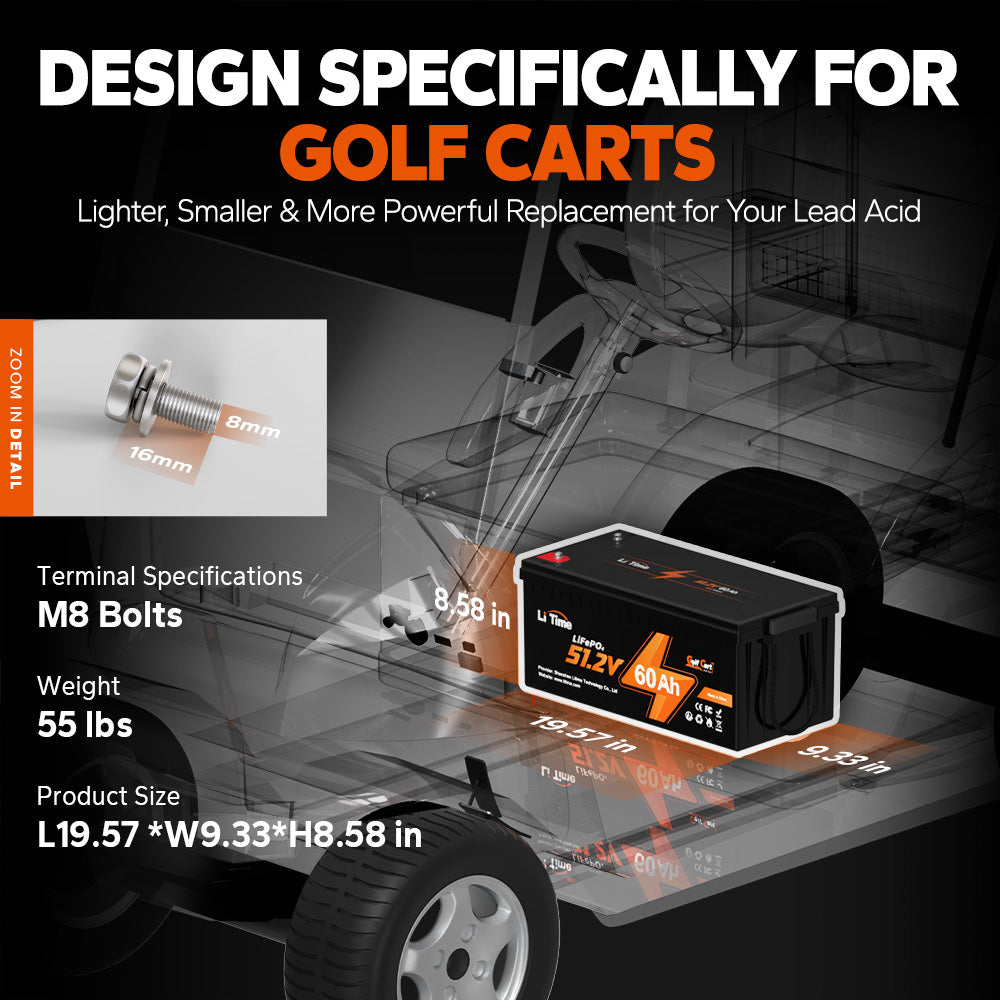

Lithium Ion Golf Cart Batteries Replacement Step-by-Step Guide
1. Select Suitable Battery Voltage and Capacity
Choose the battery voltage and capacity matching your golf cart’s specifications. Common options include 36V and 48V lithium batteries. For extended range, you can parallel-connect 2-6 batteries.
2. Remove Old Batteries and Clean the Tray
Disconnect the old batteries and remove mounting straps or brackets. Carefully remove old batteries and thoroughly clean the battery tray of dirt and corrosion.
3. Inspect Cable Condition
Check main cables thoroughly for signs of corrosion or damage. Replace them if necessary for optimal safety and efficiency.
4. Install New Batteries
After cleaning and cable inspection, place your new batteries neatly into the tray. Lithium batteries are typically drop-in solutions that require no additional adjustments.
5. Secure the Batteries
Securely fasten the batteries with appropriate mounting straps or brackets to prevent movement during operation.
6. Properly Connect Batteries in Parallel
During installation, ensure the batteries are connected in parallel by linking all positive terminals together and all negative terminals together, maintaining voltage consistency while increasing capacity.
FAQS about Lithium Ion Golf Cart Batteries
How much does it cost to swap out a lithium golf cart battery?
Replacing a lithium golf cart battery pack typically costs around $1,500–$4,000, depending on voltage, capacity, brand and labour.
How long does a lithium golf cart battery typically last?
A quality lithium golf cart battery often lasts 8–15 years, or roughly 3,000–6,000 charge cycles, if it’s sized correctly and not regularly over-discharged.
Is it safe to keep my lithium golf cart plugged in all the time?
Yes, it’s generally safe to leave a lithium golf cart plugged in if it uses a compatible smart charger and BMS, but avoid constant charging in extreme heat and follow the manufacturer’s storage guidelines.
Conclusion
Now that you understand the benefits and replacement process for lithium ion golf cart batteries, it's time to leave traditional lead acid batteries behind and welcome the era of high-performance, safer, and longer-lasting lithium technology. Choose LiTime LiFePO4 batteries, and take your golfing experience to the next level.
